If you’re a UK hiking enthusiast ready to take your adventures to the next level, glacier hiking offers a breathtaking step up from traditional hillwalking. Imagine trekking across a frozen landscape sculpted over thousands of years, with crampons gripping the ice beneath your feet and dramatic alpine scenery all around. It’s one of the most exhilarating ways to explore the natural world on foot, sitting somewhere between high-altitude hiking and non-technical mountaineering.
And the best part? You don’t need to be an expert climber or mountaineer to enjoy it. With the right guide and gear, glacier hiking is accessible to most fit and confident walkers.
As European summers grow hotter and busier, more people are looking for active holidays in cooler, more remote places. Glacier hiking offers an exciting alternative to traditional summer sports, with quieter trails and a strong sense of adventure.
Summer is the ideal time for this type of hike. The weather is more stable, visibility is better, and key glaciers become safely accessible as seasonal snow melts reveal their icy features. Plus, many of the best glacier hikes in Europe and beyond are just a few hours’ flight from the UK. The weather is more stable, daylight hours are generous, and access to glaciers is often easier with less snow covering dangerous crevasses. Plus, many of the best glacier hikes are just a short flight from the UK.
What is Glacier Hiking?
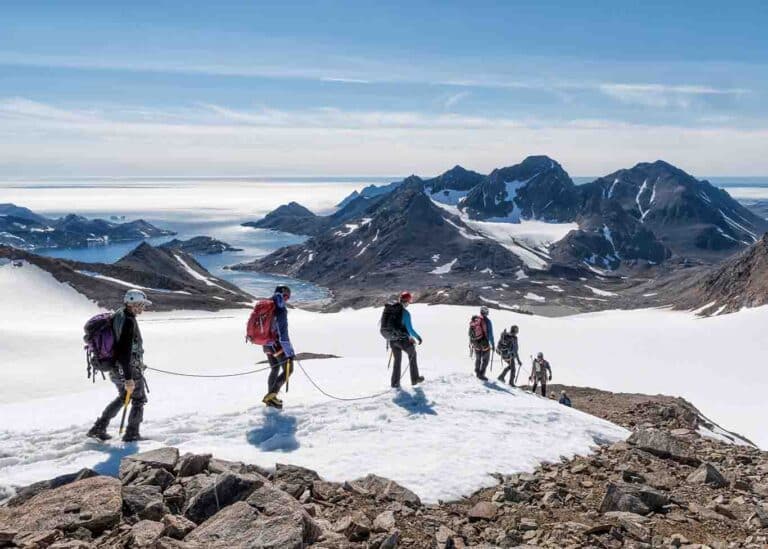
Glacier hiking is the activity of walking or trekking across the surface of a glacier, typically with the use of specialised equipment like crampons, ice axes, and harnesses. It combines elements of hiking and mountaineering, but in a more accessible way.
While some glacier routes are technical and require advanced skills, many guided hikes cater to beginners and those with a good base level of fitness. You’ll traverse icy terrain, peer into deep crevasses, and witness spectacular formations like seracs and ice caves.
Is Glacier Trekking the Same as Glacier Hiking?
In most cases, yes. The terms “glacier hiking” and “glacier trekking” are often used interchangeably. However, trekking can sometimes imply a longer or more strenuous journey, possibly over multiple days and involving glacier crossings as part of a larger alpine route. Glacier hiking usually refers to a single-day or half-day activity specifically on the glacier itself, often led by professional guides.
Iceland Glacier Hiking
Iceland is a dream for glacier hikers. With its otherworldly landscapes, you can combine glacial adventures with black sand beaches, waterfalls, and volcanoes. Most glaciers are located along the southern and southeastern coastlines, particularly within Vatnajökull National Park.
The terrain is incredibly varied, ranging from relatively gentle ice walks to more technical climbs, making it accessible for most fitness levels. Glacier hiking is extremely popular in Iceland, with a well-developed network of certified guides and daily tours departing from major hubs like Reykjavik and Vik.
Best glaciers to hike:
- Sólheimajökull: Just a couple of hours from Reykjavik, this is one of the most popular and accessible glaciers.
- Vatnajökull: Europe’s largest glacier, with multiple arms like Falljökull and Skaftafellsjökull.
- Falljökull: Known for its dramatic icefalls and relatively easy access.
Top tips:
- Always go with a guide. Conditions change rapidly, and the terrain can be deceptive.
- Bring layers, even in summer, it can get chilly on the ice.
Norway Glacier Hiking
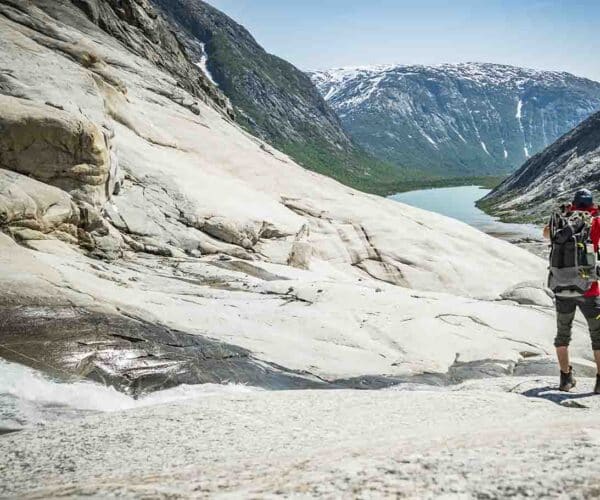
Norway is glacier country, with over 1,600 of them scattered across the western and central mountain ranges. The most accessible glaciers are found in regions like Sogn og Fjordane and Hordaland. Glacier hiking here ranges from easy guided walks suitable for families to full-day alpine treks for seasoned hikers.
It’s a popular activity during the summer months, drawing both Norwegians and international travellers, especially those keen to combine ice hiking with Norway’s famous fjords and road trips.
Best glaciers to hike in Norway:
- Jostedalsbreen: The largest glacier on mainland Europe, particularly the Nigardsbreen arm.
- Folgefonna: Offers guided hikes and even summer skiing!
Why it’s great:
- Spectacular blue ice formations.
- Family-friendly options.
- Combine with scenic drives and fjord cruises.
French Alps glacier hiking
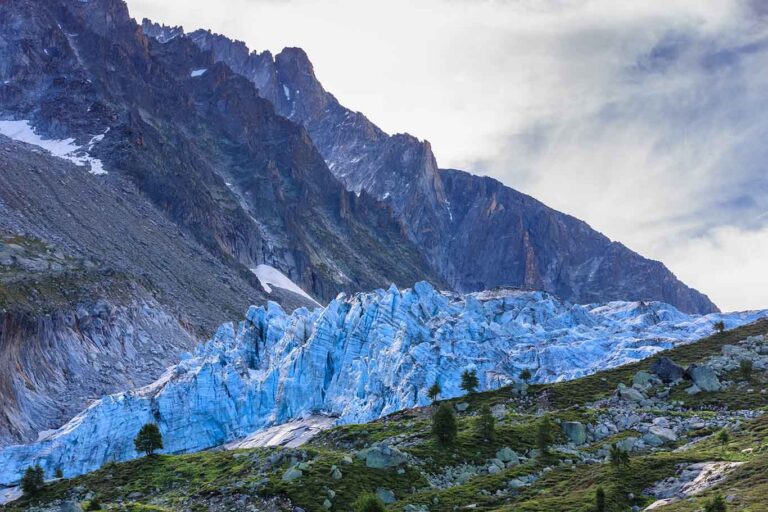
The French Alps offer a spectacular alpine setting for glacier trekking, especially around the Mont Blanc massif. The main glacier regions are centred around Chamonix and the Haute-Savoie area. Glacier hiking here varies from introductory walks suitable for beginners to demanding high-altitude treks.
The region is hugely popular among hikers, climbers, and tourists alike, and benefits from world-class infrastructure like mountain railways, cable cars, and a wide range of guides and alpine schools.
Top spots to hike glaciers in France:
- Mer de Glace (Chamonix): The most famous glacier in France, accessible via the Montenvers Railway.
- Glacier d’Argentière: For a quieter, more technical experience.
Why it stands out:
- Stunning views of Mont Blanc.
- Guided glacier hikes available for all levels.
- Excellent base in Chamonix with alpine charm and facilities.
Italy Glacier Hiking
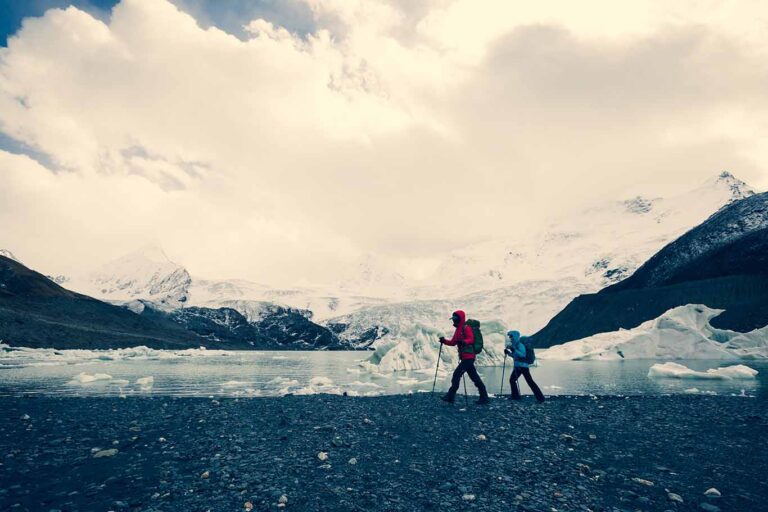
Italy offers a glorious mix of culture, cuisine, and icy adventure, with glaciers primarily located in the northwest regions bordering France and Switzerland, such as the Aosta Valley and South Tyrol. Hiking levels vary widely, from gentle routes in protected national parks to expert-level glacier traverses in the Mont Blanc and Ortler-Cevedale ranges.
Glacier trekking is popular but generally less crowded than in neighbouring countries, offering a more tranquil experience. The bonus? Some of the best food and wine you’ll ever have after a hike.
Top picks for hiking glaciers in Italy:
- Gran Paradiso National Park: Home to smaller glaciers and a more remote experience.
- Mont Blanc Massif (Italian side): Shared with France, offers sweeping vistas and expert-guided hikes.
Don’t miss:
- Refuelling with authentic Italian pasta post-hike.
- Visiting glacial lakes and high-altitude refuges (mountain huts).
Worldwide destinations for glacier hiking
If you’ve already ticked off the European greats or you’re after something truly epic, there are breathtaking glacier hikes to be found all over the world. From the jagged peaks of the Andes to the icy wilderness of Alaska, these global destinations offer a unique combination of dramatic scenery, cultural intrigue, and raw natural beauty.
Many of these spots are ideal for those looking to step out of their comfort zone and into vast, untouched landscapes where few have ventured. Craving something more far-flung? Here are top glacier hiking spots around the globe:
- New Zealand (Fox & Franz Josef): Hike through lush rainforest before strapping on crampons.
- Peru (Pastoruri Glacier): High-altitude hike in the Andes with surreal scenery.
- Patagonia (Perito Moreno): One of the most iconic glaciers in the world, still advancing!
- Alaska (Matanuska & Root Glaciers): Wild and remote, perfect for the adventurous spirit.
What to expect on a summer glacier hike
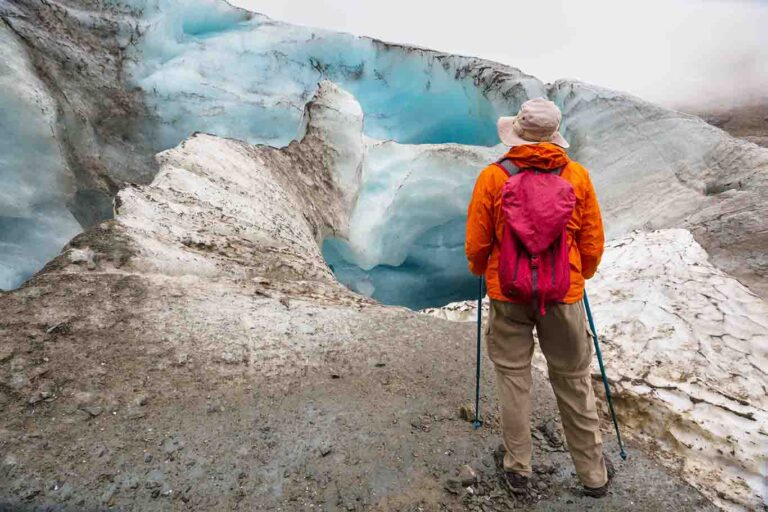
Glacier hiking in summer is unlike any other outdoor experience. You’re not just going for a walk in the mountains, you’re stepping into a dynamic, ever-shifting frozen world that requires the right preparation, gear, and mindset. Whether you’re booking a half-day guided hike or embarking on a full alpine adventure, here’s what you need to know to be ready:
Gear up
Crampons, helmets, harnesses, and an ice axe are often provided by guides. These are essential for keeping you safe and stable on the ice. Don’t worry if you’ve never used them before, most tours include a basic safety and skills briefing.
Bring your own waterproof trousers, warm base layers, insulated gloves, glacier glasses (or sunglasses with UV protection), suncream, and sturdy hiking boots. A small daypack for water, snacks, and a spare layer is also handy. Dress in layers, temperatures can swing wildly.
Weather
Glaciers create their own microclimates. Expect rapidly changing conditions – sun, wind, sleet, and snow can all occur in a single hour. While summer brings longer days and clearer skies, storms can roll in quickly.
Best months
June to September are typically the safest and most stable months for glacier hiking in the northern hemisphere.
Fitness
You don’t need to be an elite athlete, but decent cardiovascular fitness and balance help a lot. Glacier hikes often involve gentle ascents, uneven surfaces, and a steady pace. Most guided hikes accommodate various fitness levels, with plenty of breaks for photos and instruction.
Surfaces
Expect a mix of icy slopes, slushy snow, rock-strewn moraines, and even the occasional snow bridge. You’ll need to watch your footing, walk with intention, and follow your guide’s steps closely—especially in crevasse-prone areas.
A summer glacier hike is exhilarating and empowering and knowing what to expect ensures you’ll enjoy it to the fullest while staying safe.
Staying safe on the ice: Dangers of hiking on glaciers
Glacier hiking is thrilling, but the dangers are real. These are your top considerations to include in your plan and help keep you protected from the risks:
- Crevasses: Hidden cracks in the ice. Always travel roped-up with a guide.
- Weather: Conditions can change fast. Never head out without checking the forecast.
- Sun exposure: UV rays reflect off ice. Wear glacier glasses and sunscreen.
- Cold and wet: Waterproofs and thermal layers are a must.
- Falls and slips: Crampons help, but you need to learn how to walk in them. Guided tours usually include a quick lesson.
- Altitude: Some glaciers are high up—watch for signs of altitude sickness.
- Insurance: Make sure your travel insurance covers glacier hiking.
Why adventurous hikers should try glacier hiking
There’s something utterly awe-inspiring about standing on ancient ice in the height of summer. Whether you’re a seasoned hiker or just starting out, glacier hiking offers a rare blend of the unchartered, challenge, and natural beauty. It’s an experience that connects you to the raw, changing face of our planet and it’s closer to home than you might think. So why not add a glacier hike to your summer adventure list?
Get Hiking & Trekking Insurance from SportsCover Direct
As demonstrated, there are glacier hikes suitable for all abilities—from beginner-friendly ice walks to more demanding alpine adventures. One thing you absolutely shouldn’t overlook is insurance. Glacier hiking involves unique risks, and taking out specialist sports travel insurance can offer vital protection should things go awry.
SportsCover Direct has been providing glacier hiking and mountaineering insurance to adventurous travellers for decades. Our policies cover a wide range of unforeseen events, including emergency medical treatment, mountain rescue, repatriation, trip disruptions, and loss or damage to your equipment and luggage.
With cover starting from just a few pounds a month, it’s a small investment for peace of mind on a truly unforgettable trip. Learn more about our glacier hiking insurance options today and make sure you’re fully protected before stepping onto the ice.
This blog has been created as general information and should not be taken as advice. Make sure you have the correct level of insurance for your requirements and always review policy documentation.